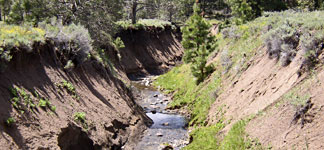|
|||||
� |
Resource Concerns >> Juniper Expansion and Sagebrush Steppe/Forest Restoration |
||||||||||
|
Juniper Expansion and Sagebrush Steppe/Forest Restoration |
||||||||||
Existing Conditions and Assessment ConclusionsThe ecological communities of the Upper Pit River watershed have changed drastically over the past 150 years. The reasons for these changes are both natural and human caused: climate, fire suppression, invasive exotic plants, agriculture, timber harvest, and livestock grazing management. One community that has experienced significant change in the recent past is western juniper, which is the dominant species for approximately 20% of the Upper Pit River watershed and is rapidly expanding throughout much of the watershed area. BLM/USFS Juniper Management Strategy estimates that this translates into a conversion of sagebrush steppe and forest to juniper woodland at the rate of 50,000 acres a year in northeast California. The concurrent histories of grazing management and fire suppression have likely facilitated the spread of juniper. Grazing management practices have decreased the amount of fine fuels (grasses and ground cover) which in turn has decreased the frequency of fire in sagebrush steppe and forest ecosystems, thus allowing juniper to expand its range. A century of fire suppression as a management practice has also allowed juniper to expand, as juniper regeneration is particularly susceptible to fire until it reaches 50 years of age. Natural fire return intervals in the Upper Pit River Watershed are 15�20 years. Juniper expansion likely would have been minimized if fire had been allowed to occur and burn seedlings and saplings. The ecological effects of juniper expansion into other vegetation communities are problematic and include the alteration of local fire disturbance and hydrologic regimes, displacement of sagebrush and other vegetation, and adverse impacts to wildlife habitat for some species including sage-grouse, mule deer, and a recently expanding elk population. Although evidence exists, mainly from Texas, that juniper expansion has a deleterious effect on water quantity in rivers, only anecdotal information exists on the affects of western juniper to water quantity in Northeast California. There are numerous accounts, including those in recent Pit RCD partner projects, where springs that have been dry for decades began flowing again after juniper removal treatments. Regardless of the effect of juniper on stream flow and soil properties, its expansion into sagebrush steppe communities is problematic for grazing and agriculture. The climax condition of the expanding juniper community can become one of complete juniper dominance where virtually all other forbs and forage disappear and springs dry up. The steady conversion of rangeland, forest and wildlife habitat in general to juniper woodland is deteriorating natural resources within the district. Juniper removal treatments are a sound practice used to achieve sustainable range management, hazardous fuel reduction and wildlife habitat improvement. Since grazing, forestry and agriculture are major economic activities in the Pit RCD it is economically advantageous to control juniper expansion. |
Juniper expansion in former sagebrush steppe.Juniper removal. The junipers compete directly with pines for nutrients and moisture, and provide a fuel ladder into the pine crowns during wildfire. |
||||||||||
|
Juniper dominates portions of the following sub-watersheds of the Pit RCD: Ash Creek, Stone Coal Creek, Widow Valley Creek, Taylor Creek, Willow Creek, Juniper Creek and along the main stem of the Pit River downstream of Canby. Currently within the Pit RCD, juniper removal and sagebrush steppe restoration work is underway. The Cooperative Sagebrush Steppe Restoration Initiative, which includes the Pit RCD, Susanville Indian Rancheria, Lassen County Fire Safe Council, Inc., University of California Cooperative Extension and Burney Forest Power, is working to restore forest and sagebrush ecosystems through the removal of invasive western juniper and the application of adaptive management techniques. The premise for the cooperative is that the encroachment of western juniper into the sagebrush steppe and forest is widely acknowledged as the single factor having the greatest impact on ecosystem and watershed health in the region and is a significant contributor to hazardous fuel loads. Management StrategyA. The Pit RCD will support treatment projects that reduce western juniper stands to pre-European settlement levels and restore our sagebrush steppe and forest ecosystems to healthy conditions. Priority projects include the following:
|
|||||||||||
